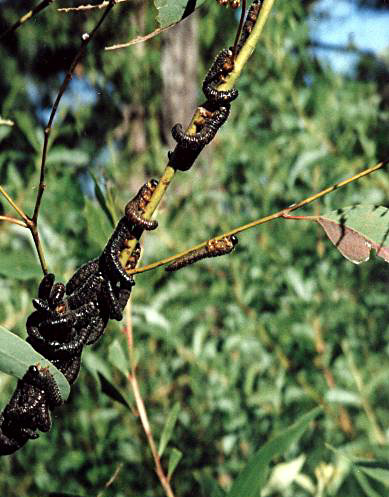Pests > Pests Entities > Insects > Ants, bees, wasps & sawflies > Sawflies > Sawfly, Perga sp., Queensland, Australia
Pests Pests Entities Insects Ants, bees, wasps & sawflies Sawflies Sawfly, Perga sp., Queensland, Australia
|
|
 |
|
|
May 2003. A member was traveling in northern Queensland, Australia, recently and saw these bugs eating vegetation voraciously and asked for an identification. They were found near the coast. The larvae seemed to work together and stay together as a group; they would move down the stem at night and then work their way back to the leaves during the day. The young ones were “leaf green”. When approached, their tails would “tap” on the stem and they would squirt a liquid from their tails.
They were recognised as sawfly larvae (Hymenoptera, family Pergidae). They are almost certainly belong to the subfamily Perginae, several species of which are known to have gregarious habits. Larvae of Perga dorsalis and Perga affinis are familiar to Canberra gardeners, especially in the late winter when the large larvae aggregate by day on branches or trunks of eucalypts. By night these larvae disperse over the tree and feed voraciously on the leaves. By tapping their rear ends on the branches they send vibrations through the wood which enables them to find each other and cluster for protection during the day. If alarmed, they tap, wave their bodies around, and regurgitate sequestered eucalypt oils. All this is pretty off-putting for a potential predator.
However, parasitism rates tend to be high and most individuals perish in the pupal stage, which is passed in the soil and litter around the base of the trees. A common name is “spitfires”. There is an account of sawflies at the Australian Museum website: www.amonline.net.au/factsheets/sawflies.htm
|
|
|
|
